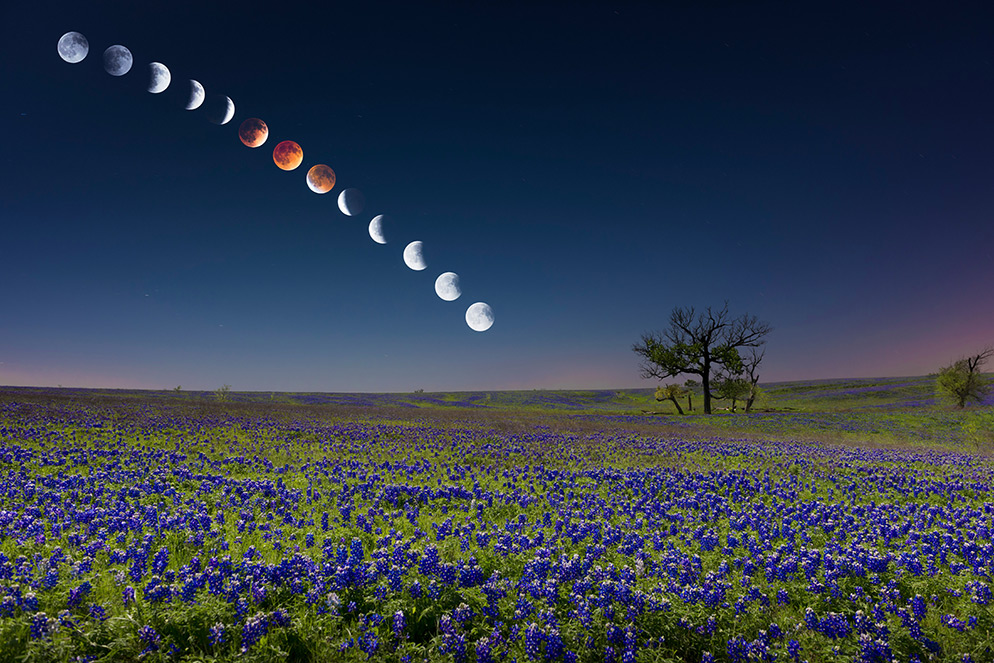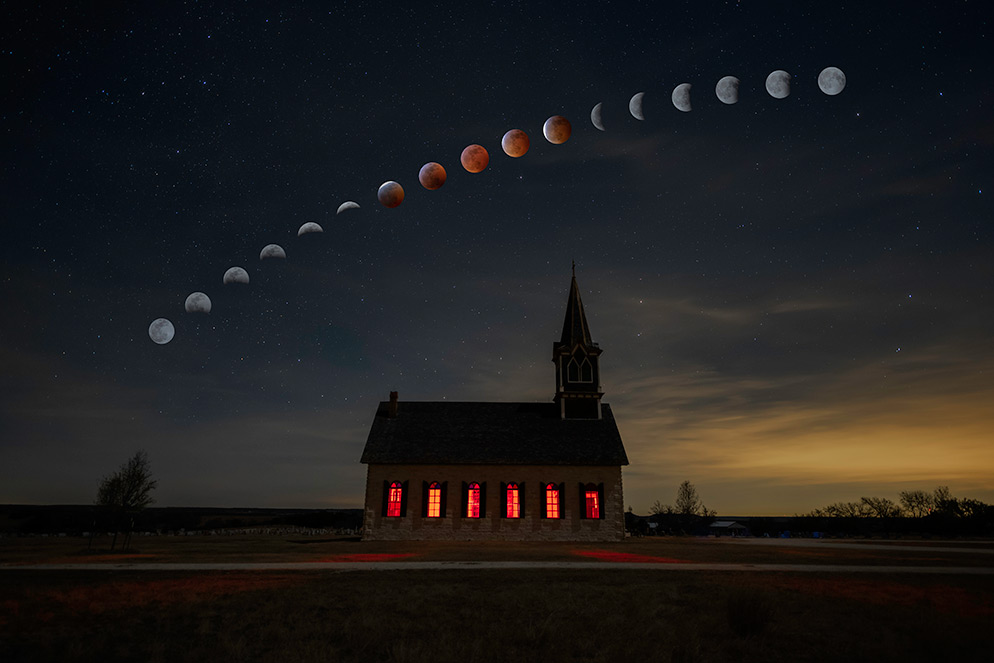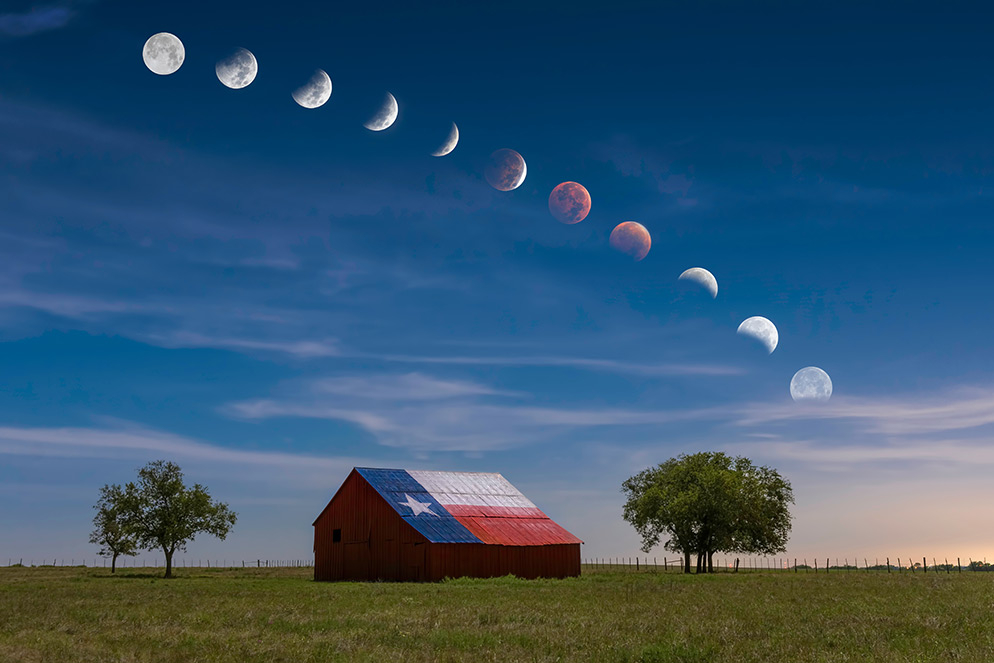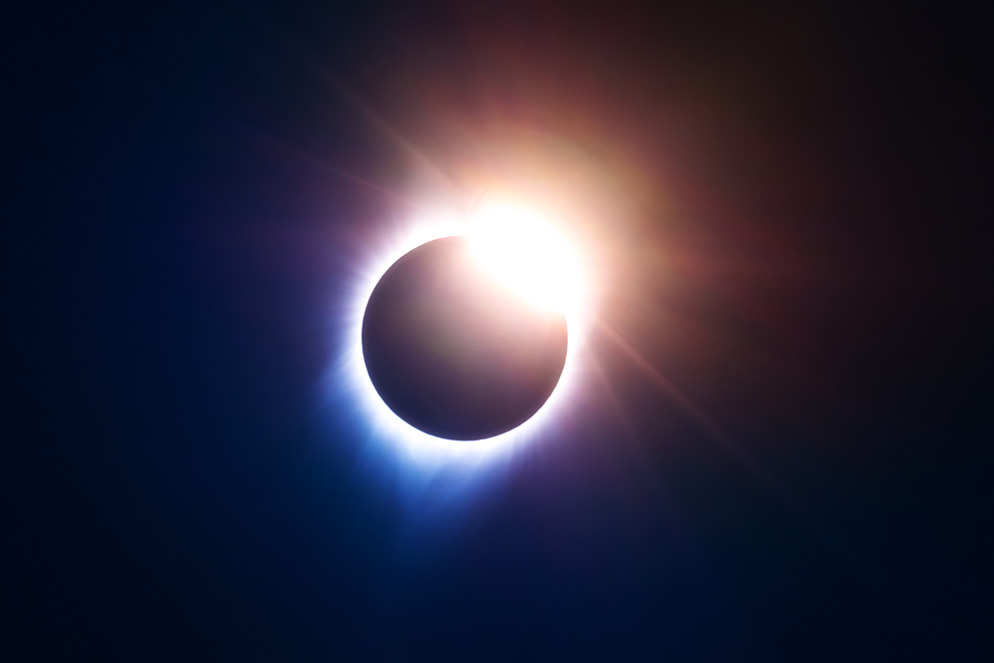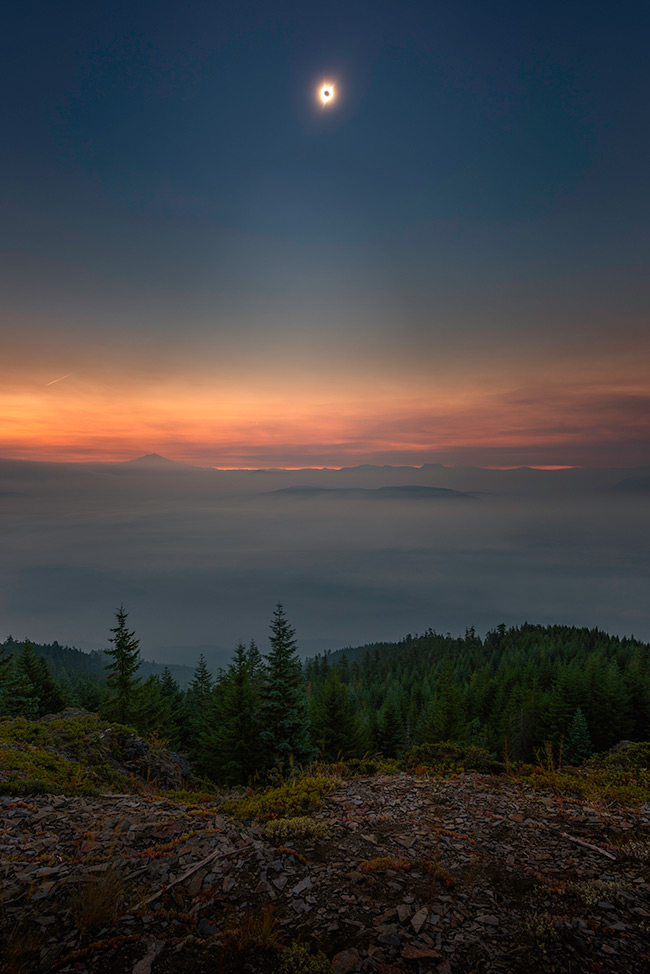Capturing and Compositing Lunar & Solar Eclipses
A composite image of the first half of the 2017 solar eclipse as seen from a top a mountain in Detroit, Oregon. The foreground image was captured with my Nikon D810 and AF-S NIKKOR 14-24mm f/2.8G ED lens and then phases of the eclipse were shot with the AF-S NIKKOR 200-500mm f/5.6E ED VR lens.
As if photographing the night sky by itself isn’t already fascinating enough, there are certain celestial events that take place each year that really up the ante. Two of those events are the lunar and solar eclipses. A solar eclipse takes place when the Moon crosses perfectly between the Earth and Sun, obscuring the sun for a brief period of time and putting Earth in the shadow of the Moon. A solar eclipse typically takes place two to four times per year, but odds are you may need to travel to another country or continent to photograph a solar eclipse. There are at least two lunar eclipses per year, and up to five on some years. A lunar eclipse occurs when the Moon passes directly behind Earth and our shadow is cast upon the Moon, turning it a fiery red. A lunar eclipse can only occur during a full moon phase. Both of these events are extremely fun to photograph and with a bit of preparation, you can let your creativity go wild.
Being a night owl, I’ve been fortunate enough to photograph four different lunar eclipses and one total solar eclipse. Now let me tell you, I absolute enjoy creating a true photograph, but for these events, it can be quite fun to create composites. With that said, whether you decide to go for the single image or composite, I highly suggest being transparent about your work to your audience.
My very first lunar eclipse composite shot in Ennis, Texas amongst a field of bluebonnets back in April of 2014.
Planning for The Event
As cool as it would be to just walk outside and say, “Oh hello, awesome eclipse”, it’s just not going to happen. So, how do I plan to photograph an eclipse? It’s really not as complicated as one may think. I use an app called PhotoPills to acquire a vast majority of information regarding the eclipse, including date, time, location, path of totality, type of eclipse, angle in the sky and more.
I tend to have a bit of creative fun and create composites with the eclipse being layered into another image with some sort of foreground. The eclipse is moved to a more “appealing” position in the sky and enlarged for visual effect. With that said, you’re probably wondering why knowing all this information is beneficial even if I’m going to move things around in post-production? Well, even with manipulating the position and scale of things, I still need to have an idea of what phases are going to be possible to capture, when and where. If part of an eclipse will be below the horizon, I need to take that into consideration because I won’t be able to document and produce the entire transition. I also need to know where the transition will begin and end so I can better forecast the weather for my shoot.
Finding Foreground
When it comes to sky photography, one of the most important features of an image is a visually appealing foreground that helps tell a story. My thinking is that you can create a photo of the sky from pretty much anywhere, but finding an element (whether man-made or natural), can help create a link between this planet and the sky above it. This foreground can be a sweeping landscape of wildflowers to a city skyline or even a historic abandoned structure. When searching for the right foreground, I always try to make sure that a balance remains between the sky and foreground element. I don’t want to photograph something that steals the show; it should accompany it. Think of your eclipse and foreground as supporting one another.
In order to find intricate foreground subjects, I’m always keeping my eyes peeled while driving around. Another good way to scout for foregrounds is to use Google Earth. I spend countless hours when I prepare for an eclipse just scouring satellite view, essentially going mile-by-mile looking for interesting shapes that could resemble abandoned buildings, fields of crop, mountain views and more.
Once you find a general location where you’d like to shoot, I highly recommend taking to social media and trying to reach out to folks who live there. I always ask locals for advice on any interesting subjects I may have in mind. For instance, if they happen to know anyone who has an old barn or abandoned vehicle on their property. I then try to get as much information in regards to the location and access and go from there. Once I’ve located my foreground, I use PhotoPills to see if the eclipse transition will take place in an appealing angle with the subject. I try my best to make the composites line up as nicely as possible with at least the viewing direction properly lining up.
Eclipse composite over the historic Rock Church in Cranfill's Gap, Texas taken in January 2019.
Forecasting the Weather
No matter how much you try, the one thing you can’t control is the weather. It’s such a love / hate relationship with clouds as a landscape photographer. You want those beautiful puffy cumulus clouds to dot your landscape at sunset, but come time for the Milky Way or say, a lunar eclipse…you want them to get the heck out of Dodge. With the inability to control mother nature, I highly suggest having an option A, B, and C for photographing any eclipse. What do I mean by that? First, have your “money shot” as option A, but just in case that location looks to be cloudy day of, have a backup location in mind. I typically space out my option A and B locations by about 50 miles. The weather and clouds can change quite rapidly and dramatically in just a short distance. My option C is usually just capturing a single, tight image of the eclipse if the clouds allow.
A few tips on how to forecast the weather…
-
Keep an eye on the weather forecast for your shooting area starting about 48-72 hours out from the eclipse.
-
Use a reputable weather forecasting tool. I highly recommend using the National Weather Service website (http://forecast.weather.gov).
-
Come the day of, pay attention to the visible satellite which shows the current cloud cover. If you loop the satellite, you can see which direction the clouds are moving and how quickly.
-
Don’t let partly cloudy skies concern you. The good thing about clouds is that they move. So, unless you’re completely socked in with overcast skies, partly cloudy skies can allow for small breaks for you to photograph the eclipse in between. This has been the case for two of my eclipse shoots.
A second go at the lunar eclipse in late 2014 over an Texas themed barn just south of Waco, Texas.
Capturing the Phases of the Moon
Alrighty, now it’s game time. You’ve scouted the perfect location for the eclipse, found an amazing foreground, and your clear skies dance has paid off. So, how do you capture the big moment? Well for the composite images in which you want to show the entire transition of the eclipse, it’s all about patience and a long lens. You want to be ready to shoot before the first hint of the eclipse takes place.
For my images, I depend on my Nikon D850 with the AF-S NIKKOR 200-500mm f/5.6E ED VR lens to capture detailed images of the moon. I typically shoot the transition images of the moon at 500mm and then crop in about 50% on the computer. The D850 gives me the resolution needed for the crop. For each image of the phases, I shoot approximately 10 minutes apart, so I have an ample number of images to choose from. It is also important to shoot your moon images on a tripod, with Vibration Reduction turned off, and use a cable release or wireless remote to trigger the camera (reducing camera shake).
It is important to note that there are some differences in camera settings between shooting a lunar eclipse versus a solar eclipse.
Solar Eclipse:
-
Do not ever look directly through your camera while it is pointed into the sun. This can result in severe eye damage. An approved pair of solar glasses is a must while shooting solar eclipses.
-
It is also incredibly important to protect your camera’s sensor. The sun can burn a hole into your sensor without a solar filter on your lens. Think of your telephoto lens as a giant magnifying glass and your sensor as the ant. In front of my Nikon 200-500mm lens, I use a Fortmatt Hitech Firecrest Solar Eclipse filter.
-
When using a solar filter, you will want to use it up to the few minutes prior to totality. Once at that point, you will need to remove the filter to photograph the Baily’s Beads, aka Diamond Ring effect, and totality. Once totality passes, put your solar filter back on the lens to continue photographing the remaining transition period.
-
Camera settings are quite simple and do not fluctuate until the moments before, during, and after totality.
-
For transition images, I typically shoot at ISO 200, f/10, 1/250s. Normally while on a tripod, I shoot 100 ISO but the bit higher ISO of 200 is due to the stops of light lost by utilizing the solar filter.
-
When it comes time to shoot without the filter, my settings are ISO 200, f/8, 1/15 second. This longer exposure time allows for the camera to be able to capture the corona light.
Lunar Eclipse:
-
Even though you’re photographing in the middle of the night, you won’t necessarily be using typical night photography settings for a lunar eclipse.
-
Lunar eclipses only take place during a full moon and the moonlight is quite strong. The typical long exposure / high ISO settings utilized for night photography will result in your images being overexposed. To photograph the full moon, I typically use these settings: ISO 200, f/7.1, 1/500 second.
-
Once again, these images are shot with my 200-500mm on a tripod, so Vibration Reduction is turned off and a cable release/wireless remote is utilized to trigger the shutter.
-
As the moon transitions into totality, your settings will have to transition as well. Ambient light from the waning Moon will be decreasing, so your settings will need to accommodate.
-
Typically, my ISO will rise, aperture will lower, and shutter speed will slow. When I find myself shooting totality, I am typically around ISO 1250, f/5.6 and ½ second. Anything slower than ½ second can result in a motion blur of the moon.
The lunar eclipse transition over the downtown Dallas, Texas skyline in September of 2015.
Capturing Your Foreground
You’ve done a lot of work to scout out the foreground for your shot, so now you need to beautifully capture it for the final image. The prime time to shoot this exposure is when the moon is at totality, so you‘ll need to act quickly in capturing your telephoto totality images and then your wide-angle foreground shot. The reason you need to shoot these images together is because if you opt to photograph your foreground at any other time, there will be too much ambient light from the moon. This will result in shadows across your scene that may not directionally match where you place the moon in your final images.
It’s also best to try to shoot a higher ISO, lower aperture and shorter shutter speed to avoid long star trails in the sky. I would recommend referring to the “500 rule” to help determine your settings for pinpoint stars. I find that having more pin point stars provides for a more realistic scene.
The 500 Rule is essentially a guideline in which one can follow to try to avoid creating star trails in their astrophotography. Some long exposures create a bit of a trail to the stars and that doesn't allow for such a nice "pin point" star effect in the sky. Essentially, for the 500 Rule, you take 500 and divide it by the focal length at which you are shooting at. That resulting numbers (I usually round down), is the number of seconds in which you can shoot at before starting to see star trails. For example, if you're shooting an 18mm focal length, you would take 500 and divide it by 18 and get 27.7, which rounded down is 27. So with that said, 27 seconds would be the target exposure length for pin point stars in your sky. As I mentioned earlier, I would use the 500 Rule as a guideline as their are still some other variables like how close you are viewing the image or how big you may print it, that can affect whether or not a star is "pinpoint' or not.
As for lens choice, I shoot with my AF-S NIKKOR 14-24mm f/2.8G ED lens at the wider end. This gives me plenty of space (no pun intended) to place my moon transition within the image. I always recommend shooting a bit wider than you think you’ll need, so you can crop if needed. Note: Feel free to add a bit of spice to your image by illuminating the inside of your foreground if possible with a color that contrasts the night sky.
A telephoto image of the "diamond ring effect" during the 2017 total solar eclipse in Oregon. Nikon D810, AF-S NIKKOR 200-500mm f/5.6E ED VR lens, f/13, 1/40 second, ISO 400.
Assembling the Composite
Ah, at last…you have all the pieces to the puzzle and now you just need to create the final image. I utilize both Adobe Lightroom and Photoshop. You can use any image editing software that will allow you to use layers.
Whether you’re creating a lunar or solar eclipse composite, the processes are about the same.
I Import all the images from the shoot into Lightroom and edit the foreground image to obtain the mood for the composite. I edit the foreground first so I have an idea of just how bright or dim I want the eclipse to appear. Once I get my foreground to a point I’m happy with, I begin to work on the eclipse totality image. I try to get that image to a point in which it’s ambient light relatively matches the mood of my foreground image. From this point, I edit one of the transition eclipse images to my preferred liking, copy and paste the settings to all the other transition images. Typical edit adjustments include white balance, exposure, whites, clarity and removing chromatic aberration. Once all images have been edited, I select all and open as layers within Photoshop.
Now your creativity can be let loose. Use your foreground image as the foundation to your composite and build off of that. I tend to arrange all my layers with the first eclipse sequence being the closest to the bottom and the last eclipse sequence being the top layer. Once I’ve achieved the correct sequence order, I turn off the visibility of each layer except the first sequence and foreground. There are two techniques that I use to add my eclipse into the scene. For any eclipse phase that is perfectly round, I use the circular marquee tool to cut it out from the background. If the eclipse is in a waning or waxing stage, I then use either the “screen” or “lighten” blend mode. I then use the transform option to shrink the eclipse to my desired size and place it where I want. I repeat these steps for every part of the sequence. In a nutshell, that’s how I create my eclipse composites!
Plan accordingly, take your time, get creative, and be transparent to your audience!
During totality of the 2017 solar eclipse. Due to the eclipse, sunset colors were seen along the horizon in every direction. D810, AF-S NIKKOR 14-24mm f/2.8G ED, f/8, 10 seconds, ISO 31.


